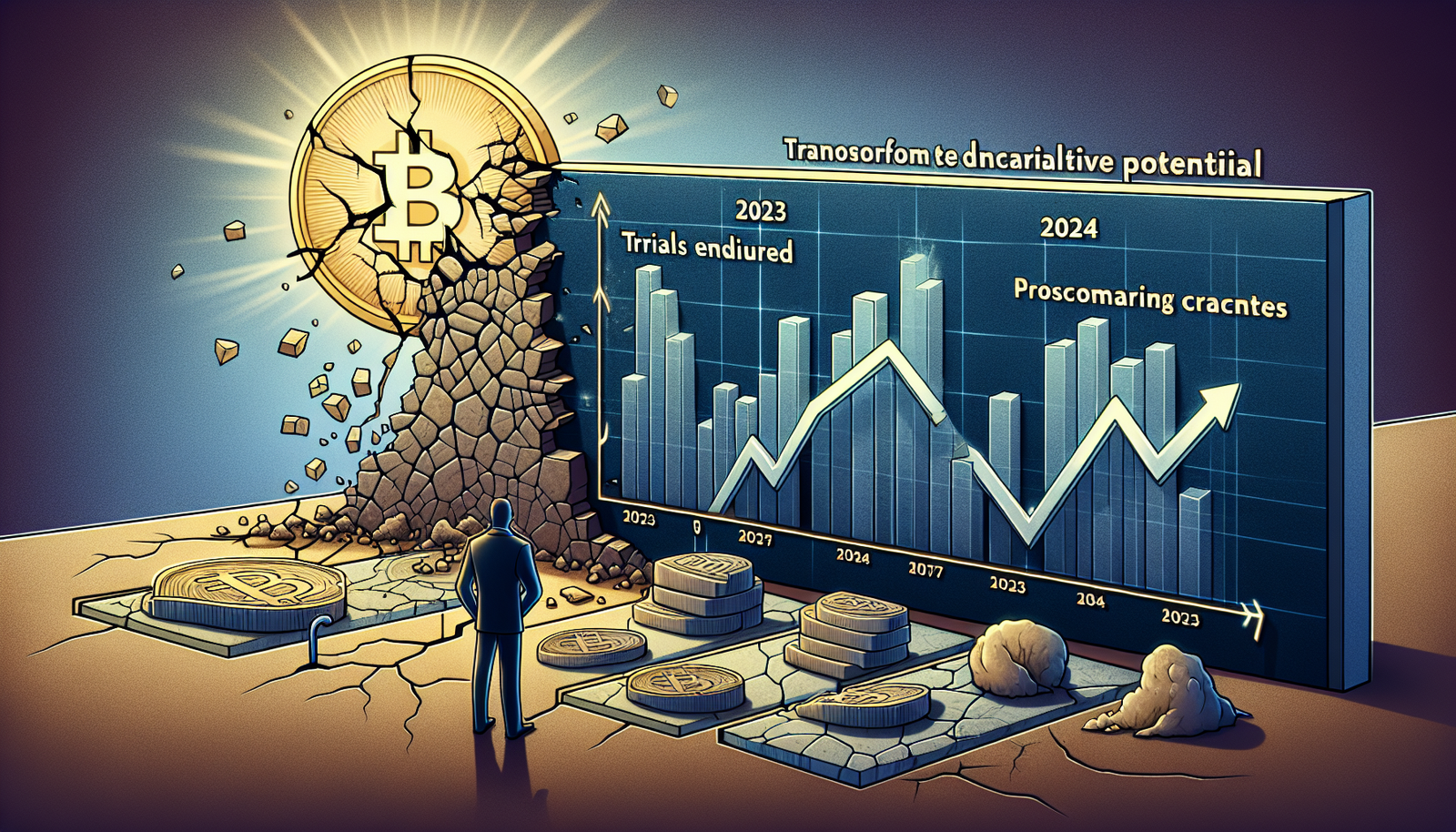Market optimism is high, but caution is warranted due to overlooked risks in tech stocks and Fed rate cuts.
February 11, 2024 | by stockcoin.net


Market optimism may be running high, but a word of caution is warranted as a result of overlooked risks in tech stocks and impending Federal Reserve rate cuts. While the tech industry has been a major driver of market growth, there are potential pitfalls that investors should not ignore. Additionally, risks are mounting in commercial real estate and regional banks, with the potential for defaults and refinancing challenges. However, amidst these uncertainties, there are opportunities for investors to find safety and growth in stocks such as CME, Chevron, and Public Storage. These companies offer resilient dividends and have high credit ratings, with low default probabilities. By investing in these stable stocks, investors can navigate the uncertain economic conditions and potentially outperform the market.
Market optimism

High levels of optimism in the market
The current market is experiencing high levels of optimism, evidenced by the continuously rising stock prices and positive market sentiment. Investors and analysts alike are hopeful about the future prospects of various industries and are eagerly investing in stocks. This optimism can be attributed to factors such as strong economic growth, low interest rates, and positive corporate earnings.
However, it is important to exercise caution amidst the prevailing market optimism. While the overall sentiment is positive, there are certain risks that are being overlooked, particularly in the tech sector.
Caution is warranted
Amidst the prevailing market optimism, caution is warranted as there are risks that may dampen the market sentiment in the long run. One area of concern is the undervaluation of risks in tech stocks. With the rapid advancement of technology and the increasing dependence on tech companies, there is a potential for market turbulence if these companies encounter unexpected challenges or fail to live up to the high expectations set by investors.
Additionally, the tech sector is vulnerable to economic downturns. In times of economic uncertainty or recession, consumer spending tends to decline, and this can adversely affect tech companies that rely heavily on consumer demand for their products and services. It is essential for investors to carefully evaluate the risks associated with tech stocks and diversify their portfolios to mitigate potential losses.
Overlooked risks in tech stocks

Undervaluation of risks in tech stocks
The current optimism in the market has led to a significant undervaluation of risks in the tech sector. Investors are piling into tech stocks, driven by the belief that these companies will continue to dominate and grow exponentially. However, it is crucial to assess the potential risks and vulnerabilities that come with investing in this sector.
One of the key risks is the potential for market turbulence. Tech stocks are often subject to high volatility, with sharp price fluctuations driven by market sentiment and changes in consumer preferences. In the event of adverse market conditions or a shift in investor sentiment, tech stocks may experience significant declines in value.
Moreover, the tech sector is highly sensitive to economic downturns. During economic recessions or periods of uncertainty, companies may cut back on their technology investments, resulting in reduced revenue and profitability for tech companies. Investors need to be aware of these risks and consider the potential impact on their investment portfolios.
Fed rate cuts
Impact of Federal Reserve rate cuts on market sentiment
The Federal Reserve’s decision to cut interest rates has had a significant impact on market sentiment. Lower interest rates typically lead to increased borrowing and spending, which stimulates economic growth and supports stock market performance. The rate cuts have been perceived positively by investors, contributing to the high levels of optimism in the market.
The lowered interest rates have made borrowing more affordable for businesses, enabling them to invest in expansion and innovation. This has fueled expectations of improved corporate earnings and future growth, further driving stock prices upward.

Potential risks associated with rate cuts
While Federal Reserve rate cuts have boosted market sentiment, there are potential risks associated with this monetary policy. One concern is the potential for inflationary pressures. The lower interest rates encourage borrowing and spending, which can lead to excessive demand and subsequently drive up prices. If inflation becomes a significant concern, the Federal Reserve may need to reverse its rate cuts to control inflation, which could negatively impact market sentiment.
Another risk is the potential for asset bubbles to form. As interest rates decline, investors may search for higher returns in riskier investments, such as stocks or real estate. This increased demand can potentially drive up asset prices to unsustainable levels, leading to a bubble that may burst when market conditions change. Investors should evaluate the potential risks associated with rate cuts and adopt a cautious approach to their investment decisions.
Uncertainty regarding future rate cuts
There is considerable uncertainty surrounding future rate cuts by the Federal Reserve. While the central bank has provided guidance indicating potential further rate reductions, the timing and magnitude of these cuts remain uncertain. The outcome of various economic factors, such as GDP growth, inflation, and geopolitical tensions, will shape the Federal Reserve’s decision-making process.
Investors should carefully monitor the Federal Reserve’s statements and announcements for any indications of future rate cuts. It is crucial to remain informed and prepared for potential shifts in market sentiment as a result of changes in interest rate policy.
Risks in commercial real estate

Increasing risks in the commercial real estate sector
The commercial real estate sector is facing increasing risks that have the potential to impact market stability. Commercial properties, such as office buildings, retail spaces, and industrial facilities, are sensitive to changes in economic conditions, making them vulnerable to market downturns.
One of the primary risks in the commercial real estate sector is the potential for defaults and refinancing challenges. When economic conditions deteriorate, businesses may struggle to generate sufficient cash flow to cover their lease or mortgage payments. This can lead to a higher rate of defaults on commercial property loans, impacting lenders and potentially causing financial instability.
Potential for defaults and refinancing challenges
The economic impact of the COVID-19 pandemic has highlighted the potential for defaults and refinancing challenges in the commercial real estate sector. With businesses shutting down or facing reduced revenue, many commercial tenants have been unable to meet their rent obligations. This puts pressure on property owners and lenders to renegotiate lease agreements or restructure loan terms.
Furthermore, refinancing challenges may arise as property owners find it difficult to secure new loans or extend existing ones. Lenders may become more hesitant to provide financing, leading to a tightening of credit availability in the commercial real estate market.
Investors should carefully assess the risks associated with commercial real estate investments, taking into account current market conditions, tenant occupancy rates, and lease maturities. Diversification across different property types and locations can help mitigate the potential impact of defaults and refinancing challenges.
Rising risks in regional banks

Growing concerns about regional banks
There are growing concerns about the risks associated with regional banks. Regional banks, unlike larger national or international banks, primarily serve local communities and businesses. These smaller banks are often more exposed to regional economic conditions and may face greater challenges during periods of economic uncertainty.
Regional banks typically have a concentrated loan portfolio, with a significant portion of their assets tied to local businesses. This concentration exposes them to the economic performance and financial health of the specific regions they operate in. If these regions experience economic downturns or face industry-specific challenges, regional banks may suffer increased default rates and higher credit losses.
Potential for increased default rates
The current economic landscape has heightened the potential for increased default rates among regional banks. With many businesses struggling to generate sufficient revenue, loan delinquencies and defaults may rise, affecting banks’ profitability and balance sheets. This can significantly impact investor confidence and put downward pressure on regional bank stock prices.
It is essential for investors to carefully evaluate the asset quality and loan exposures of regional banks before making investment decisions. Understanding the local economic conditions and the potential risks faced by the bank’s borrower base is crucial to assess the potential impact on the bank’s financial performance.
Challenges in refinancing
The challenges that regional banks may face in refinancing can compound the risks associated with their loan portfolios. As economic conditions worsen, borrowers may struggle to meet their loan obligations, creating a higher demand for refinancing. However, regional banks may find it challenging to refinance existing loans due to tightening credit conditions and increased lender caution.
This lack of refinancing options can lead to a higher rate of loan defaults and credit losses for regional banks. Investors should closely monitor the refinancing landscape and consider the potential impact on regional banks’ profitability and stability.
Safety and growth in stocks
Finding safety and growth opportunities in the market
Amidst the risks and uncertainties in the market, investors can identify safety and growth opportunities by carefully selecting stocks that exhibit resilience and potential for long-term growth. These stocks often possess stable fundamentals and have demonstrated the ability to weather economic downturns.
Investors should prioritize stocks of companies operating in sectors with strong long-term prospects, such as healthcare, infrastructure, and essential services. These sectors tend to be less affected by economic cycles and have a stable demand for their products or services.
Stocks like CME, Chevron, and Public Storage
Some stocks that offer both safety and growth potential include CME Group Inc. (CME), Chevron Corporation (CVX), and Public Storage (PSA).
CME Group Inc. is a global derivatives marketplace that provides a wide range of products, including futures and options contracts. The company benefits from its well-established position in the financial industry, offering market participants tools to manage risks effectively. The demand for derivatives products remains resilient even during challenging market conditions, making CME a safe bet for investors seeking stability.
Chevron Corporation, one of the world’s largest integrated energy companies, operates across the entire energy value chain. The company has a strong balance sheet and generates consistent cash flows, thanks to its diversified portfolio of upstream and downstream operations. Chevron’s focus on optimizing operational efficiency and expanding its renewables business positions it well for long-term growth.
Public Storage is a leading self-storage real estate investment trust (REIT), providing individuals and businesses with secure storage solutions. The demand for self-storage remains stable, even during economic downturns, as people often downsize or need additional space for their belongings. Public Storage’s extensive portfolio and well-established brand make it a reliable choice for investors seeking both safety and growth.
Resilient dividends and potential outperformance
In uncertain economic conditions, stocks with resilient dividends can provide investors with a stable income stream and potential capital appreciation. Companies with a track record of consistently paying dividends and increasing dividend payments over time are often viewed favorably by income-oriented investors.
Furthermore, stocks with the potential for outperformance may generate higher returns compared to broader market indices. Companies that have a competitive advantage, strong management teams, and innovative products or services often stand out in their respective industries.
Investors should conduct thorough research and analysis to identify stocks that offer a balance of safety and growth potential. Diversification across different sectors and careful consideration of stock valuations are crucial for building a resilient and promising investment portfolio.
High credit ratings and low default probabilities
Importance of credit ratings in uncertain economic conditions
In uncertain economic conditions, the importance of credit ratings cannot be overstated. Credit ratings provide an assessment of an issuer’s ability to meet its financial obligations and repay its debts. They act as a guide for investors, helping them evaluate the creditworthiness and risk profile of potential investments.
High credit ratings indicate a low level of credit risk, signaling that the issuer is likely to make timely principal and interest payments on its debt obligations. This provides investors with a sense of security and stability, especially during periods of economic volatility.
Stability provided by stocks with high credit ratings
Stocks with high credit ratings offer a level of stability and resilience that can be highly valuable to investors. These companies have demonstrated financial strength and the ability to withstand economic downturns or market turbulence. They are typically less affected by adverse economic conditions and tend to continue generating stable cash flows, supporting their dividend payments and overall financial stability.
Investing in stocks with high credit ratings can help mitigate the risk of default and potential losses during economic downturns. These companies often have strong balance sheets, lower debt burdens, and established business models that position them well for long-term growth and profitability.
Low default probabilities as an indicator of resilience
Low default probabilities serve as an indicator of a company’s resilience and financial health. Stocks with low default probabilities are less likely to experience financial distress or default on their debt obligations. This can provide investors with confidence in the company’s ability to weather economic challenges and continue delivering shareholder value.
Low default probabilities are typically associated with stable industries and companies with strong cash flows, consistent earnings, and prudent financial management. Investors should consider stocks with low default probabilities as potential investments, conducting thorough analysis of the company’s financial statements, industry dynamics, and economic outlook.
In conclusion, market optimism is currently high, driven by factors such as strong economic growth and positive market sentiment. However, caution is warranted as there are overlooked risks in the tech sector and potential risks associated with Federal Reserve rate cuts. The commercial real estate sector and regional banks are also facing increasing risks, which may impact market stability. Nevertheless, investors can find safety and growth opportunities in stocks with resilience and potential for long-term growth. Stocks with high credit ratings and low default probabilities offer stability in uncertain economic conditions. It is crucial for investors to thoroughly evaluate the risks and potential rewards of their investments to build a resilient and successful investment portfolio.

RELATED POSTS
View all




